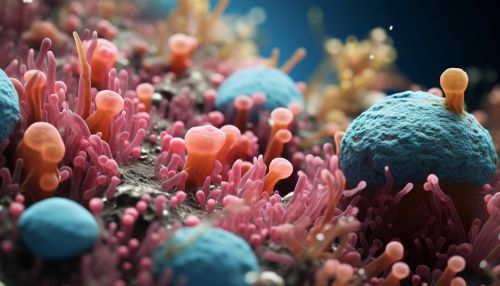Infection
Overview
An infection is the invasion of an organism's body tissues by disease-causing organisms, their multiplication, and the reaction of host tissues to the infectious agents and the toxins they produce. Infections are caused by infectious agents such as viruses, viroids, prions, bacteria, nematodes such as parasitic roundworms and pinworms, arthropods such as ticks, mites, fleas, and lice, fungi, and other macroparasites.
Types of Infections
Infections can be classified by the causative agent as well as by the location in the body where the infection is found.
By Causative Agent


Infections can be caused by a variety of organisms, including:
- Bacteria - These are single-celled organisms that can cause infections such as strep throat, urinary tract infections, and tuberculosis.
- Viruses - These are smaller than bacteria and can cause diseases such as the common cold, influenza, and HIV/AIDS.
- Fungi - These are multicellular organisms that can cause infections such as athlete's foot, ringworm, and yeast infections.
- Parasites - These organisms live on or in a host organism and can cause diseases such as malaria, giardia, and toxoplasmosis.
By Location
Infections can also be classified by the location in the body where the infection is found:
- Local - This is where the infection is limited to one area of the body.
- Systemic - This is when the infection spreads throughout the body.
- Focal - This is when the infection starts as a local infection but then spreads to other parts of the body.
Symptoms and Signs
The symptoms of an infection can vary greatly depending on the type of infection and the location in the body. However, common symptoms often include fever, fatigue, muscle aches, and a loss of appetite. In some cases, infections can also cause more specific symptoms such as a cough with a lung infection or a rash with a skin infection.
Diagnosis
The diagnosis of an infection often involves a combination of history taking, physical examination, and diagnostic testing. Diagnostic tests may include blood tests, urine tests, imaging studies such as X-rays or CT scans, and in some cases, biopsies or cultures of the infected tissue.
Treatment
The treatment of an infection depends on the type of infection and the severity of the symptoms. Treatment may include antibiotics for bacterial infections, antiviral medications for viral infections, antifungal medications for fungal infections, and antiparasitic medications for parasitic infections. In some cases, supportive care such as rest, hydration, and over-the-counter medications to relieve symptoms may be all that is needed.
Prevention
Prevention of infections can involve a variety of strategies including good hygiene practices, vaccination, and in some cases, prophylactic medications.
